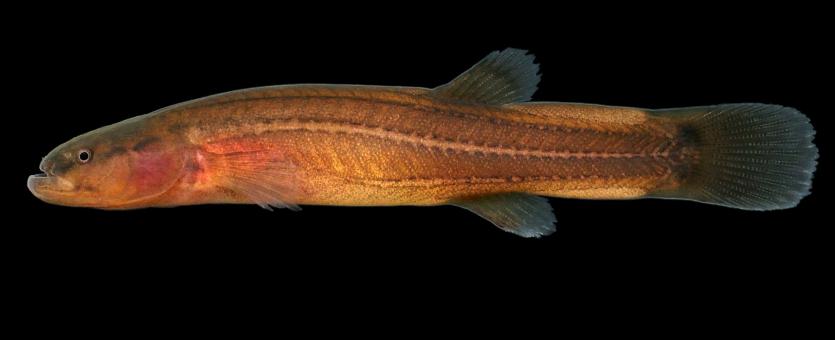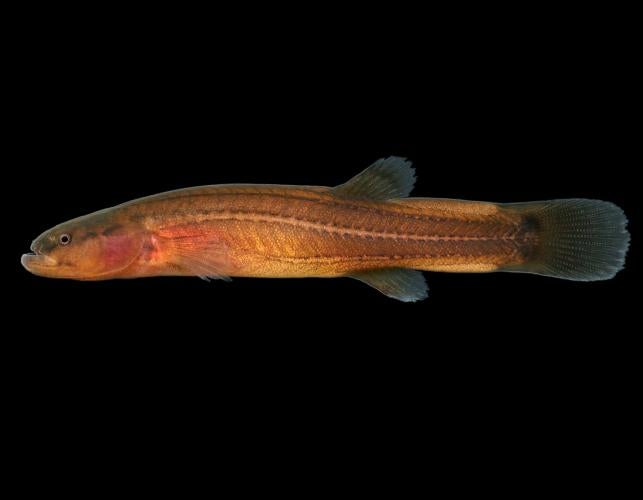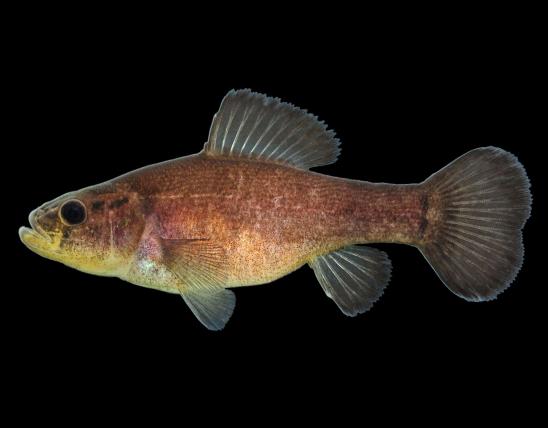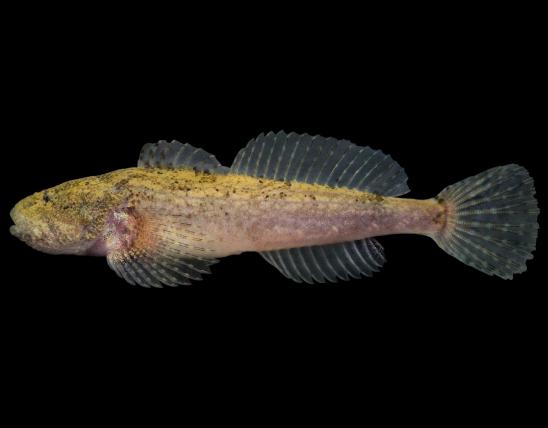
The spring cavefish is the only cavefish in our state that has eyes and whose body is yellowish brown or brown; our other cavefishes lack eyes and are pale and nearly colorless. This fish resembles a salamander, with a single dorsal fin without spines, a rounded tail fin, and very small eyes. The scales are so small that the body appears naked. Pelvic fins absent; anus far forward of the anal fin, on throat of adults. The head and body have numerous rows of sensory papillae (budlike protuberances). Back is dark brown to nearly black, grading to lighter brown on sides and cream-yellow on the belly. Often there is a thin yellow stripe along each side. Fins are dusky or clear.
Similar species: Our two other cavefishes, the Ozark cavefish and the southern cavefish, are both unpigmented and blind. Another Missouri fish associated with caves is the grotto sculpin, but it is unrelated to the minnowlike cavefishes and has a very different body shape.
Length: from about 2 to 2½ inches (adults), with a maximum of about 3 inches.

A single population in our state occurs in Scott County, in a small spring issuing from the base of tall limestone bluff onto the Mississippi alluvial plain. The entire species occurs in southern Illinois, central Tennesee, and west to this one location in Missouri.
Habitat and Conservation
Cavefishes occupy specialized habitats and are seldom encountered unless you are looking for them. This species occurs in caves, springs, spring runs, and spring seeps. It appears to be intermediate between “obligate cave dwellers” such as the southern cavefish, and fish species that complete their life cycle in surface waters.
Conservation efforts include protecting a cave's recharge area (the area of land through which water moves into springs or caves), minimizing disturbance to cave wildlife, and protecting cave entrances.
For a single cave system, the recharge area can be many miles wide. Pollutants, such as agricultural chemicals and animal waste, roadway runoff, leaking septic tanks, contaminants from trash thrown into sinkholes, and even excess silt from a variety of construction and agricultural earthworks, can seep into the groundwater, polluting caves, springs, and well water.
Food
This species depends on taste rather than sight or smell to find its food. The bulk of the diet seems to consist mainly of amphipods, which are a group of small aquatic crustaceans.
Status
Because of its small numbers and limited distribution within our borders, this fish is a Species of Conservation Concern in Missouri and has been declared State Endangered.
Life Cycle
The spring cavefish usually stays underground in the daytime, emerging into surface waters at dusk and retreating underground an hour or so before dawn. Its eyes function only to distinguish between light and darkness. Details of this fish’s reproductive biology are unknown. They appear to breed underground, and the eggs might be incubated in the gill chamber, as in the northern cavefish. Most live only to about 2 years, perhaps 3.
Human Connections
Human wealth takes many forms, in addition to the common sense of “money.” That Missouri — the Cave State — is blessed with such interesting subterranean features and an abundance of fascinating, rare, and elegant creatures, makes us rich beyond description.
Aquatic caves — ones with permanent or nearly permanent water — are fascinating, unique, and fragile. Humans have only a limited understanding of aquatic cave species and their interconnections.
Ecosystem Connections
Our three species of cavefishes live in specialized habitats. As some of the top underwater predators where they live, they occupy an important position.
There are many other remarkable animals that are so specialized for living in caves that they cannot survive outside the cave environment. These include cave crayfishes, the grotto sculpin and grotto salamander, and several species of flatworms, cave snails, arachnids, amphipods, copepods, isopods, millipedes, insects, and more.
Because they cannot live without a cave, and because they are limited in our state to a single cave system, a single pollution event affecting the groundwater seeping into the cave can potentially wipe out the entire population.



























